Popular culture is currently witnessing an undeniable explosion in the representations of previously underrepresented, marginalized groups. In film, African Americans and Asian Americans enjoyed big-screen, box office triumphs in Black Panther and Crazy Rich Asians, respectively, both of which were long overdue. The televisual landscape is even more diverse — one can witness nuanced, thoughtful, and culturally specific explorations of families hailing from different backgrounds in Blackish, Fresh off the Boat, and Ramy. RuPaul Charles brought drag culture to mainstream viewers in a highly glamorized, but largely depoliticized, fashion in Rupaul’s Drag Race, while Pose is considered an Emmy frontrunner for its beautiful yet exacting portrait of the poor, disenfranchised black and brown participants of New York’s ballroom scene in the late 80’s/early 90’s.
Despite all these steady advancements, there are still many groups whose stories are underexplored. There remains a dearth of indigenous characters on television, and the visibility of gay men still dwarfs that of lesbians, especially queer and lesbian women of color. Additionally, in the history of primetime television, there have been but a handful of interracial, female same-sex relationships to hit the small screen, and rarely have these couplings involved Asian American women. However, the overall invisibility of queer/lesbian Asian women in the annals of television does not necessarily indicate a corresponding absence of nonnormative (n.b. deviating from a societal ‘norm’) expressions of desire. Framing this piece around desire offers a capaciousness that allows for the exploration of alternative impulses — beyond romantic/sexual attraction — within a ‘relationship.’
Thus, I want to hone in on the cultural politics of interracial, female same-sex desire vis-à-vis two contemporary TV series — Ally McBeal (1997–2002) and Killing Eve (2018-present). On both shows, an Asian American woman is the object of a white woman’s desire, and vice versa, though neither pair is an official, monogamous couple. Despite the fact that the two series are separated by two decades and narratively and stylistically very different, I believe it is productive to read them in conversation with one another to examine what they each reveal about the performance of affect, desire, and intimacy, as well as the prevailing social and political attitudes on same-sex, interracial desire that characterize each moment.
Ally McBeal: The Flaming Hot Kiss
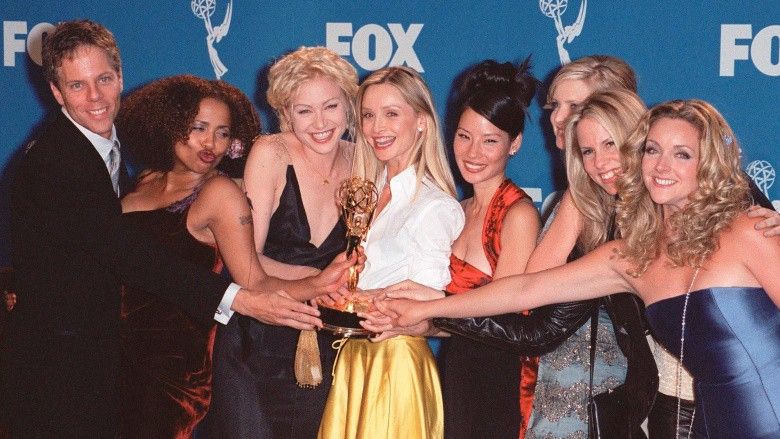
During the 1990’s, there were few Asian faces on television, barring news anchor Connie Chung. One of the splashiest — and most controversial — Asian American characters appeared near the end of the decade, on a show that managed to capture the zeitgeist and provoke heated debates about feminism — Ally McBeal. For those who are uninitiated, it is a legal dramatic-comedy about a white woman named Ally McBeal (Calista Flockhart) who works at a prestigious law firm and struggles to flourish in her romantic and personal life. This law firm is inhabited by a kooky band of misfits, including Lucy Liu’s Ling Woo, a Chinese American lawyer who joins the show in season two. Ling was emphatically positioned as the antithesis to Ally: whereas Ally was diffident, indecisive, and a hapless romantic, Ling was confident, caustic, and generally disinclined towards relationships. Though initially conceived as a guest star, the character was a hit with audiences and became a prominent presence on the show.
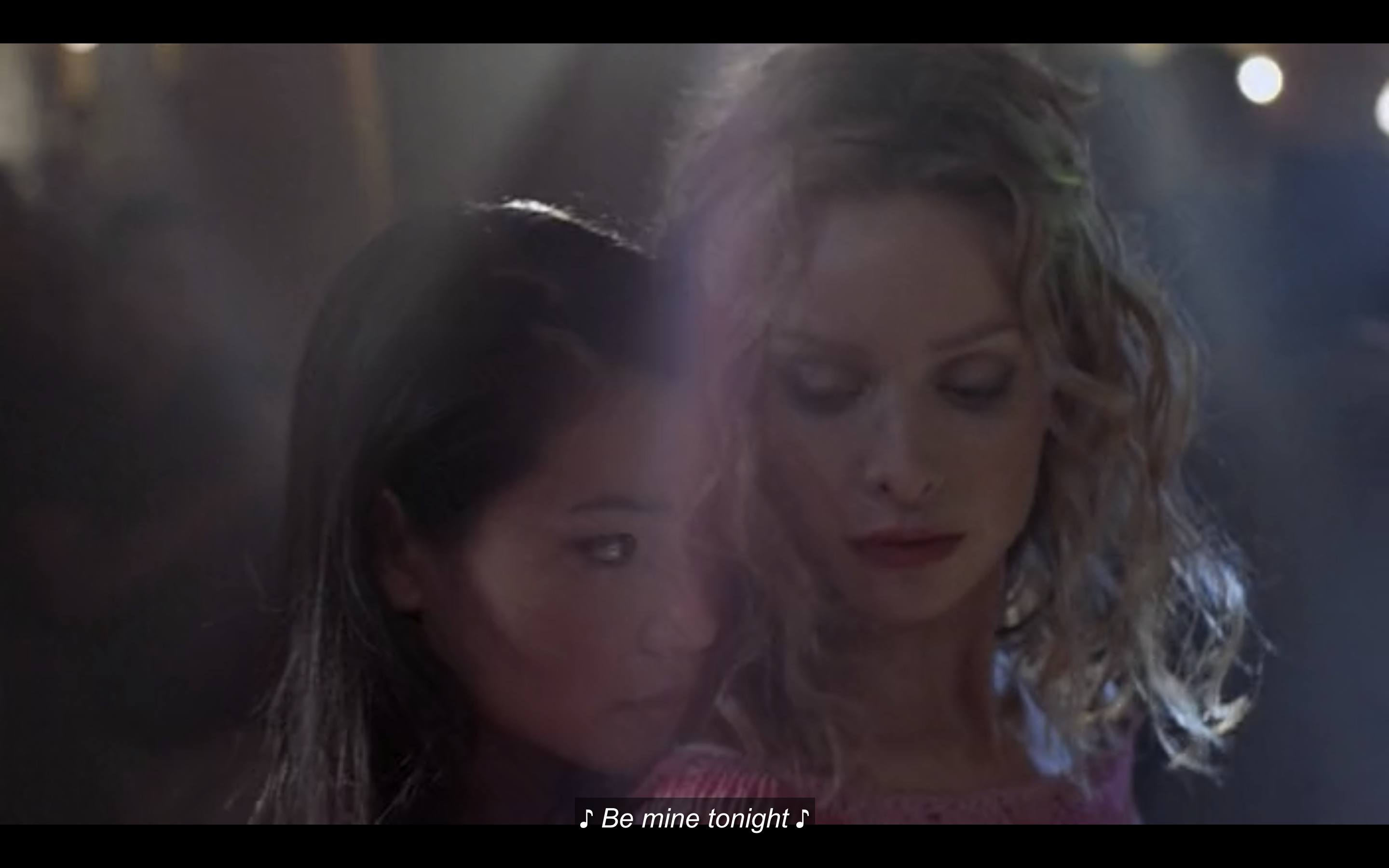
The series was notorious for its deliberately campy flirtations with lesbianism, despite the fact that none of the characters identify as such. In one of the most memorable (and scandalous) moments in the show’s five year history, Ling and Ally share a steamy, impassioned kiss that set both Nielsen ratings records and FCC sensors ablaze. This scene occurs in Season 3, episode 2, aptly titled “Buried Pleasures,” which begins with Ling admitting to having a “gay erotic dream” about kissing Ally and proceeds to lay out how their reciprocal desire congeals. After some initial hesitation, the two sworn enemies decide to go out for dinner and drinks, which leads to them dancing with one another in the middle of a piano bar. It is not at all platonic, mind you, but rather sensuous, combustible, and loaded with hip-to-hip bumping and grinding action, mesmerizing the mostly male patrons.
As they prepare to part ways for the night, Ally and Ling agree to indulge each other’s curiosity and kiss, “just to see what it would be like.” They proceed to engage in a passionate lip-lock that lasts nearly a minute as the camera lingers on their softly surprised, sexually satiated faces. An intimate connection is at last established between the two, and catharsis of the simmering sexual tension achieved. Is this, as the lyric of the extradiegetic soundtrack suggests, a genuine expression of both women’s desires?
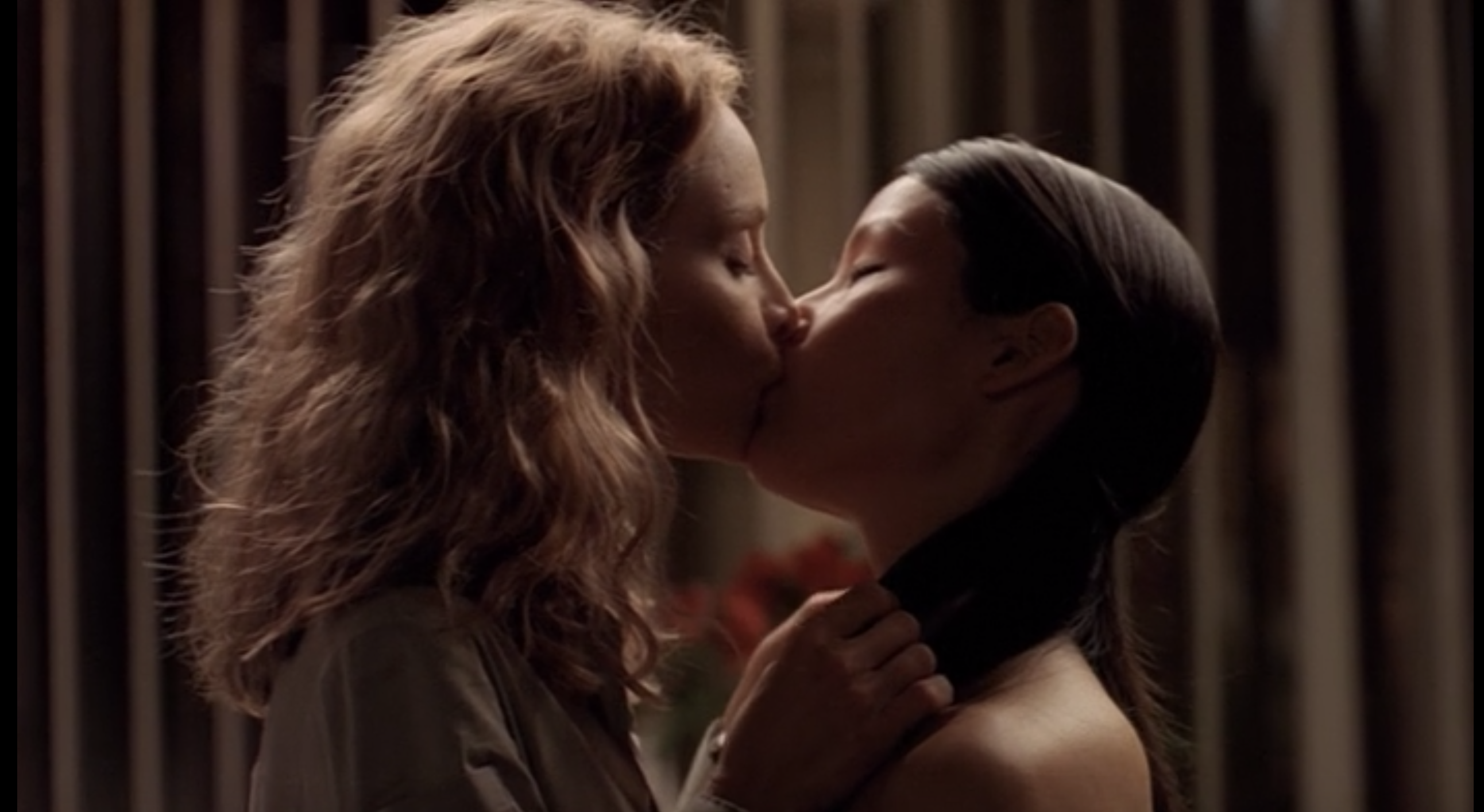
Nevertheless, ultimately, the heterosexuality of both characters has to be reaffirmed. The women share the sentiment that as enjoyable as the kiss was, it is not something that they want to try again. Near the end of the episode, Ling’s partner Richard facetiously asks her if she is “feeling hetero again,” to which she responds, “pretty much,” as they share a slow dance. This apparent conclusion to Ling and Ally’s all-too-brief dalliance is rather unsurprising, given the socio-political landscape of the 1990s. This was an era that continued to be ravaged by the AIDs epidemic, saw the passage of the military “Don’t Ask Don’t Tell” policy, and bore witness to the massive fallout (including death threats) from Ellen DeGeneres’s nationally televised coming out on her sitcom The Ellen Show. In light of all this, showrunner David E. Kelley likely made a calculated decision to frame same-sex desire as an ephemeral mode of playful escapism in Ally McBeal, after which one returns securely to the arms of her male lover.
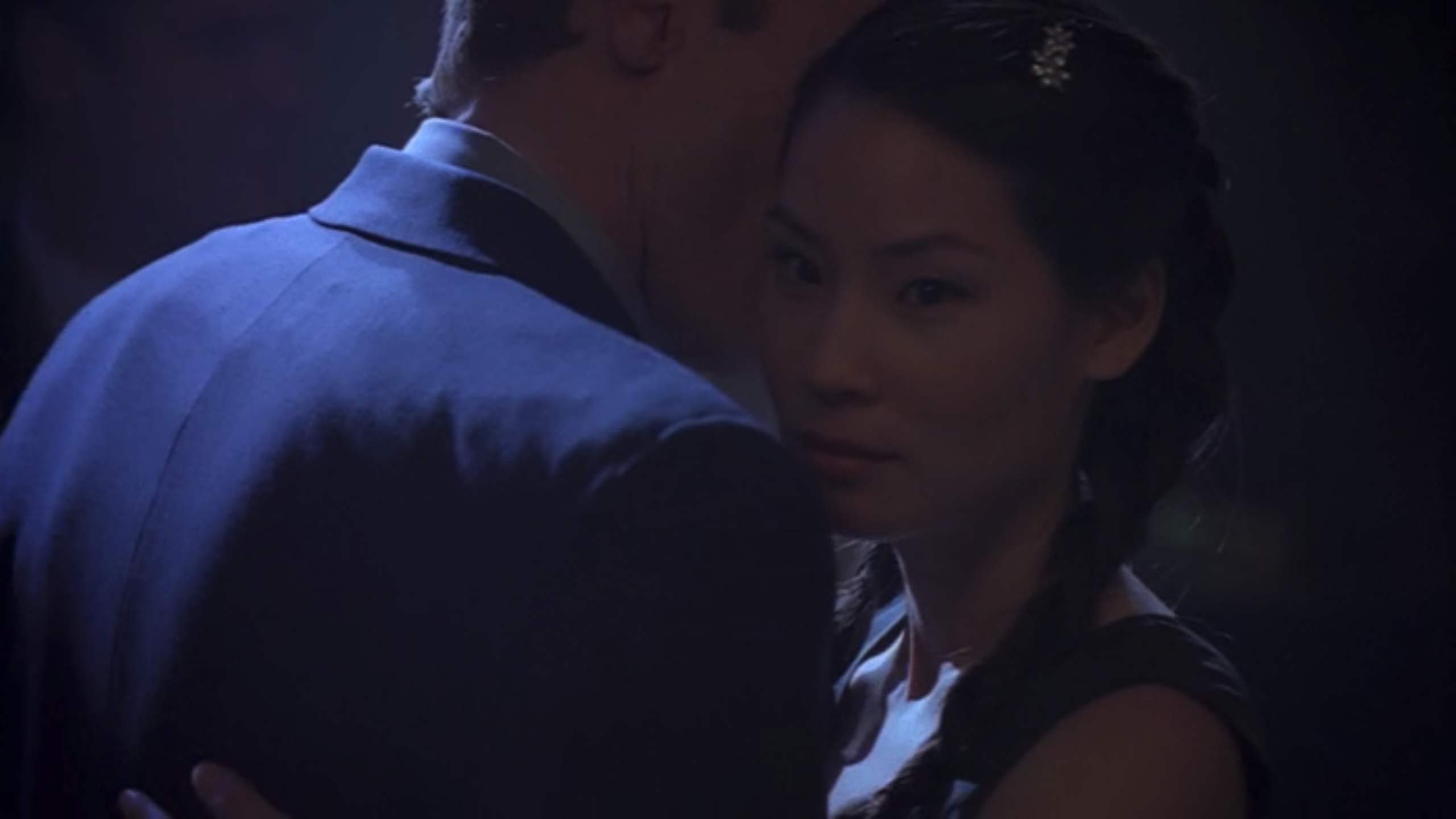
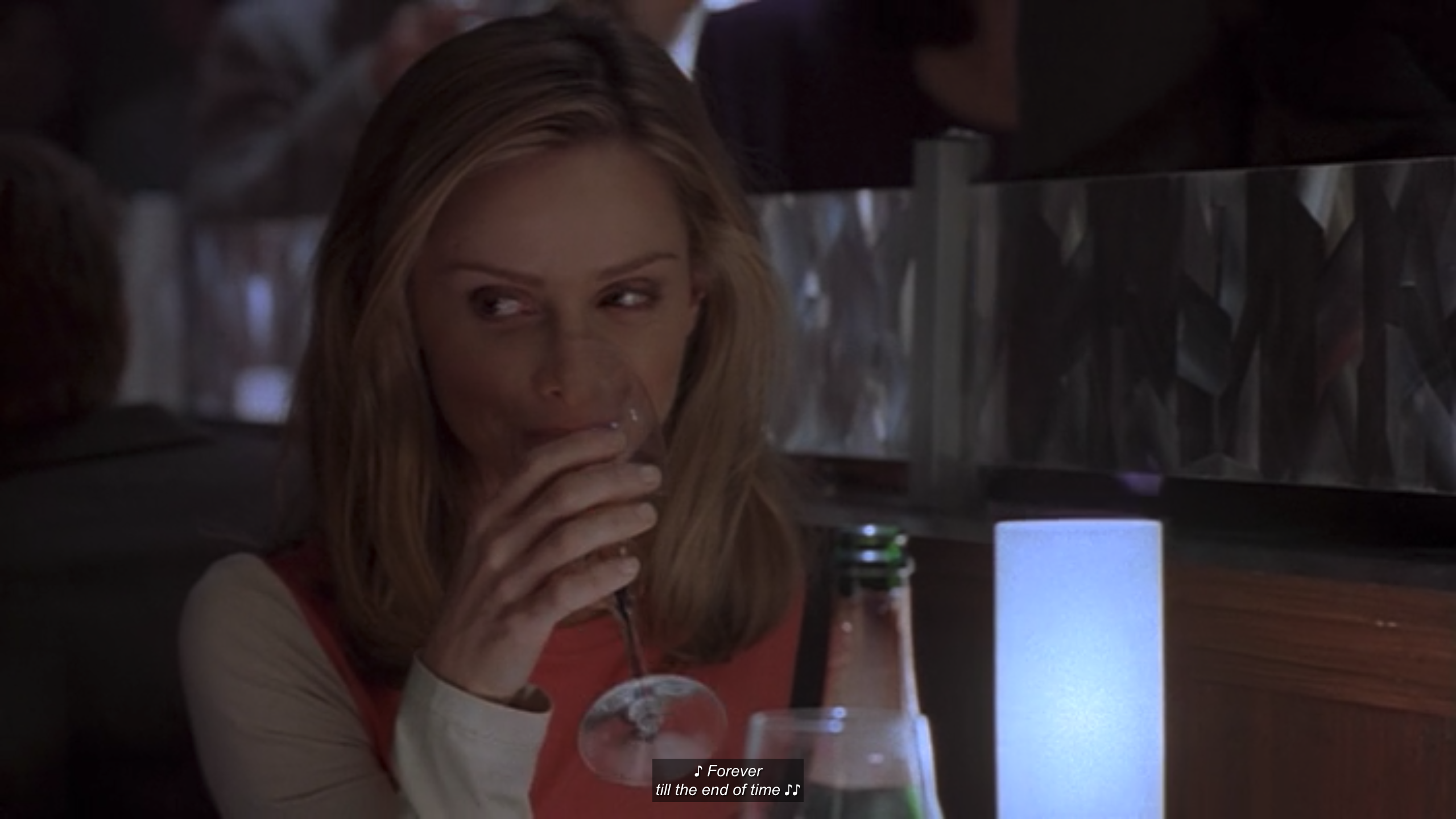
However, there are elements of desire and longing that cannot be fully contained. The “Buried Pleasures” episode closes with Ally glancing out onto the dancefloor, where Ling and Richard are slow-dancing. As Richard leans in to kiss Ling on the cheek, Ling turns her head to the left. The camera pans to Ally’s face, clearly surprised by Ling’s deliberate stare. Then, Ling smiles at Ally coyly, and there is a moment of understanding as the object of the other’s address. Ally returns Ling’s deliberate stare with a wide eyed smile, perhaps demonstrating a somatic slip that betrays her previous, vociferous declarations that she is “not a lesbian!” As queer theorist Juana Maria Rodriguez contends: “Gestures are always partial; they never fully establish the interpretive closure of an action or articulate intent. They can only suggest, and that functions as a form of seduction(emphasis mine).” Thus, as their story goes, Ling and Ally kiss, then go their separate ways, never articulating the interiority of their desires to/for one another. And yet, they reveal, through one last stolen glance and knowing smile, their shared moment of pleasure and ecstasy.
Killing Eve: A Tantalizing Tango
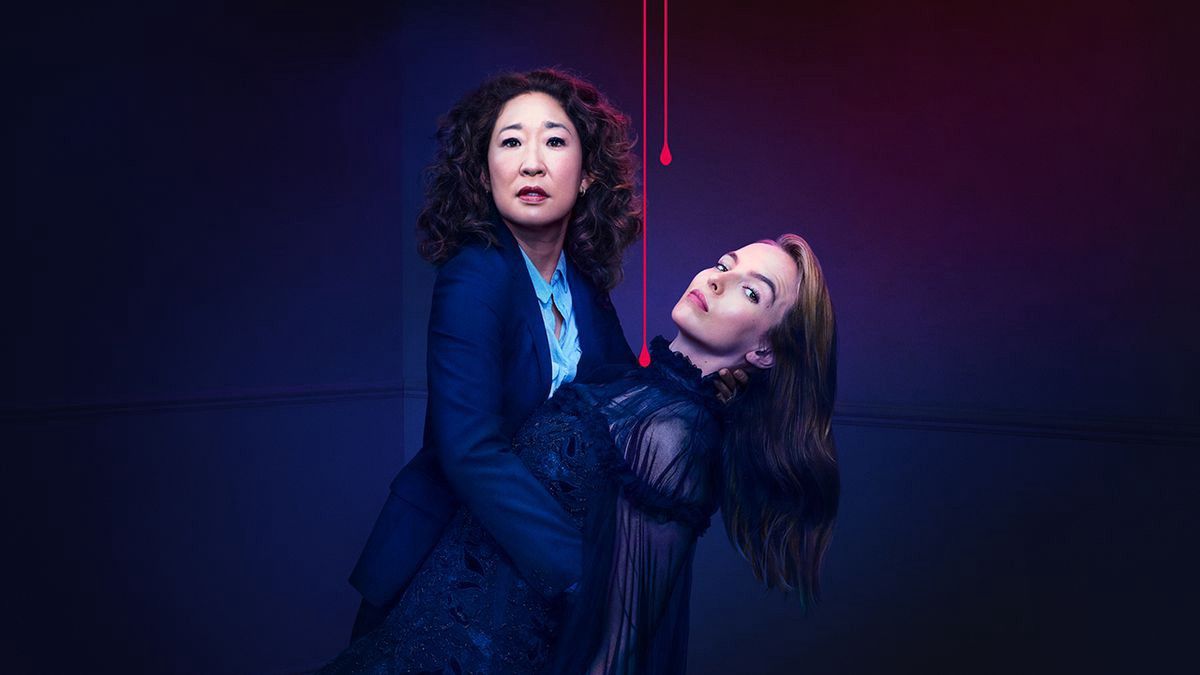
So, where are we now? Are televised images of interracial same-sex desire still as fleeting today? I want to turn now to Killing Eve, one of last year’s breakout television series, which foregrounds female homosociality and depicts Asian American female sexuality in a much different manner than Ally McBeal. To provide a brief synopsis, Sandra Oh plays Eve Polastri, a mid-level British intelligence officer who becomes fixated on catching a psychopathic serial killer (Jodie Comer’s Villanelle). As the cat and mouse between the two women progresses, Eve is utterly transformed by her assignment to subdue Villanelle: she starts to inhabit different bodily and emotional dispositions, such as fearlessness, rage, and deadpan hilarity. Villanelle, meanwhile, should be trying to evade capture, but she finds herself intrigued by the “Asian woman with the amazing hair” and in fact starts to leave deliberate clues at crime scenes designed to lure Eve closer. Each of their encounters bristles with affective intensity and homoerotic curiosity. The two are engulfed in an astoundingly intricate web of desire; that is, they seemingly want to kill, be, and be with one another, all at the same time.
After spending the previous seven episodes slowly encircling each other’s orbit, in the season one finale, “God I’m Tired,” Eve manages to track down Villanelle’s chic Parisian apartment. She is in the midst of a cathartic exercise in trashing the place when Villanelle unexpectedly returns. Eve instinctively aims her gun at Villanelle but does not immediately pull the trigger, prompting Villanelle to goad Eve into shooting her, while intuitively knowing that she won’t. She snarkily asserts, “You like me too much,” an assertion Eve does not deny. Eve, at this point, has grown too attached to the object of her desire, so much so that it nearly becomes her.
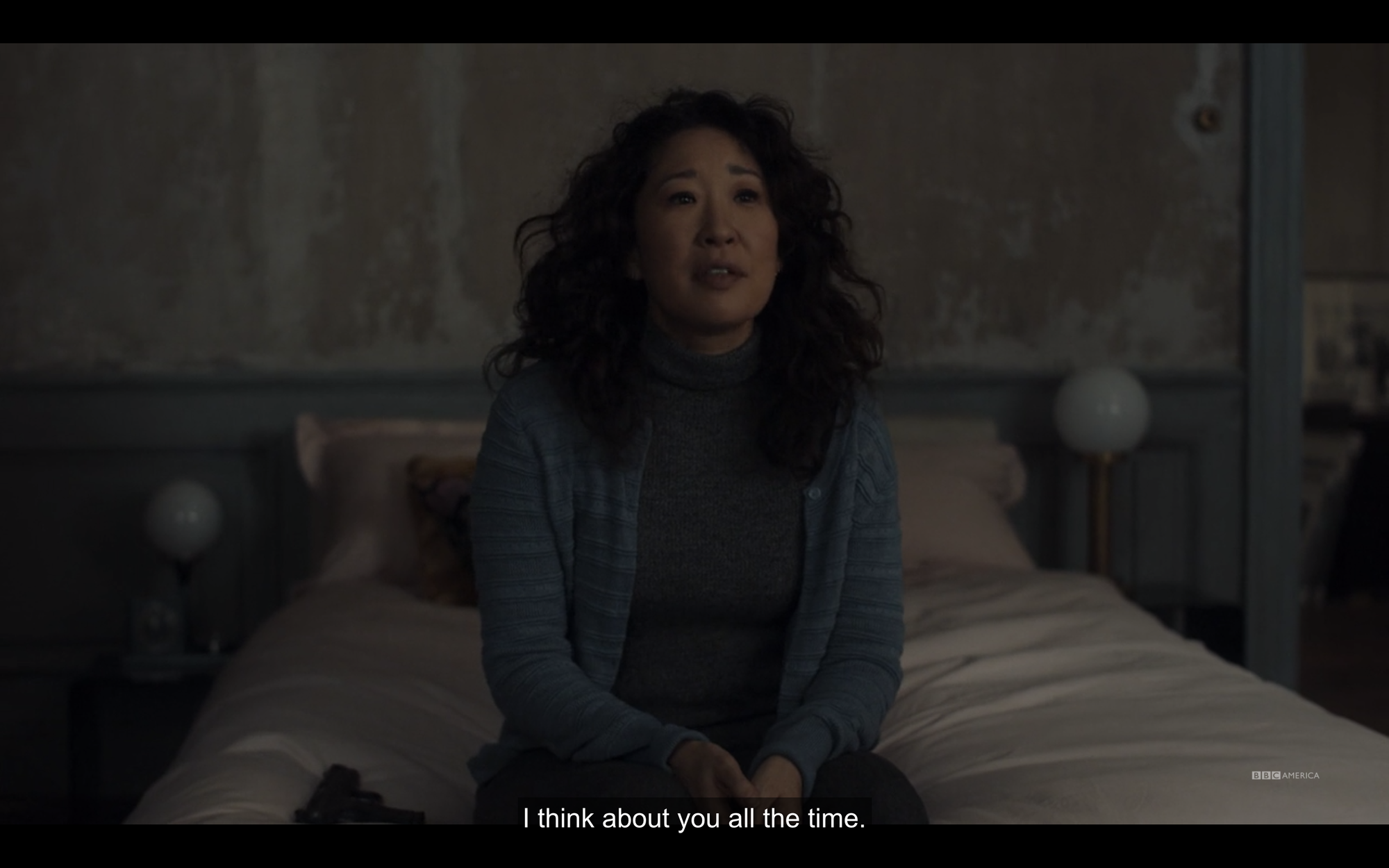
Eve’s hesitance to shoot and ultimately eliminate this sociopathic killer reveals a subconscious recognition that Villanelle is an inextricable part of her life and psyche now. After all, her entire world revolves around Villanelle, to whom she admits: “I think about you all the time.” Eve has become fully enraptured by the serial killer she is supposed to apprehend. They proceed to share a heart to heart, in which Villanelle reveals that what she craves is normalcy, confessing her fantasy for ”a quiet life…[and] someone to watch movies with.” These two women find themselves continually, and rather inexplicably, drawn toward one another, when all rational sensibility would impel them to stay away from each other.
In a sense, the nature of their relationship parallels the affective structure of what literary scholar Lauren Berlant diagnoses as ‘cruel optimism,’ such that the “pleasures of being inside a relation become sustaining.” Certainly for Eve, the thrill of the Villanelle case (and chase) has become her life-sustaining force, as she has actively defied the orders of her superior and essentially forgotten about her husband. Villanelle has similarly absconded with her dangerous Russian handlers in her relentless fascination with Eve. Both women, through their affectively charged encounters, are able to enact fantasy projections of a better life vis-à-vis one another. But to what end?
As they lay down their defenses, they start to caress each other tenderly in bed, but just as Villanelle leans in for a kiss, Eve covertly pulls out a knife and proceeds to stab her. In a brilliantly written and acted sequence, the show thwarts viewers’ expectations of the consummation of their long-running sexual tension, instead demonstrating yet another way in which Eve has become like Villanelle. In other words, Eve takes a page out of Villanelle’s playbook of emotional manipulation, managing to deceive her by feigning romantic interest and performing inexperience with same-sex encounters. She has, at long last, subdued Villanelle. But almost immediately, she regrets her decision, quickly overcome with guilt and horror about possibly having mortally wounded the object of her life-sustaining desires and fantasies. Season one concludes with Villanelle stumbling off screen while Eve fumbles around for first aid, leaving an abject Eve demanding to know where she could have gone.
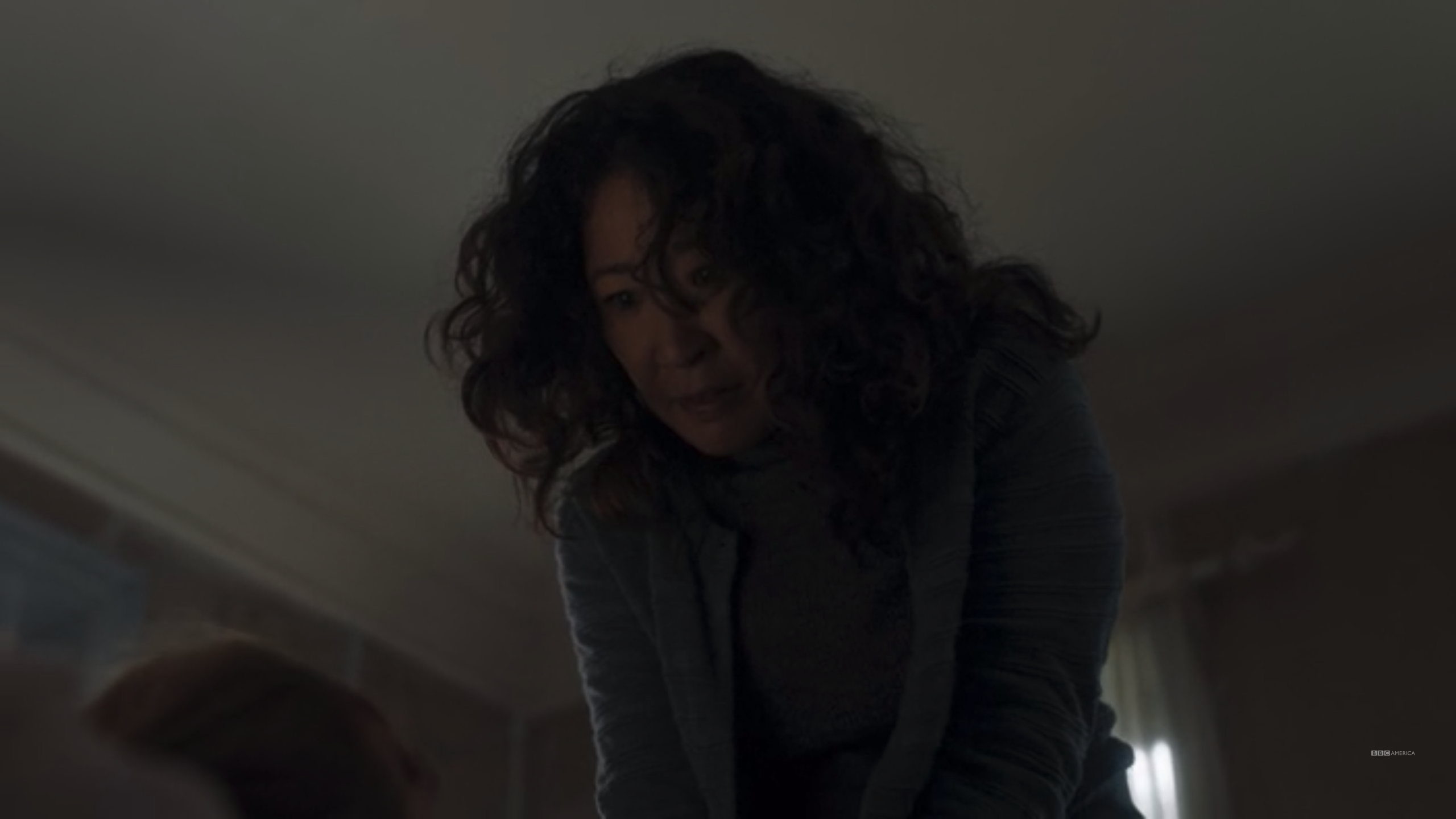
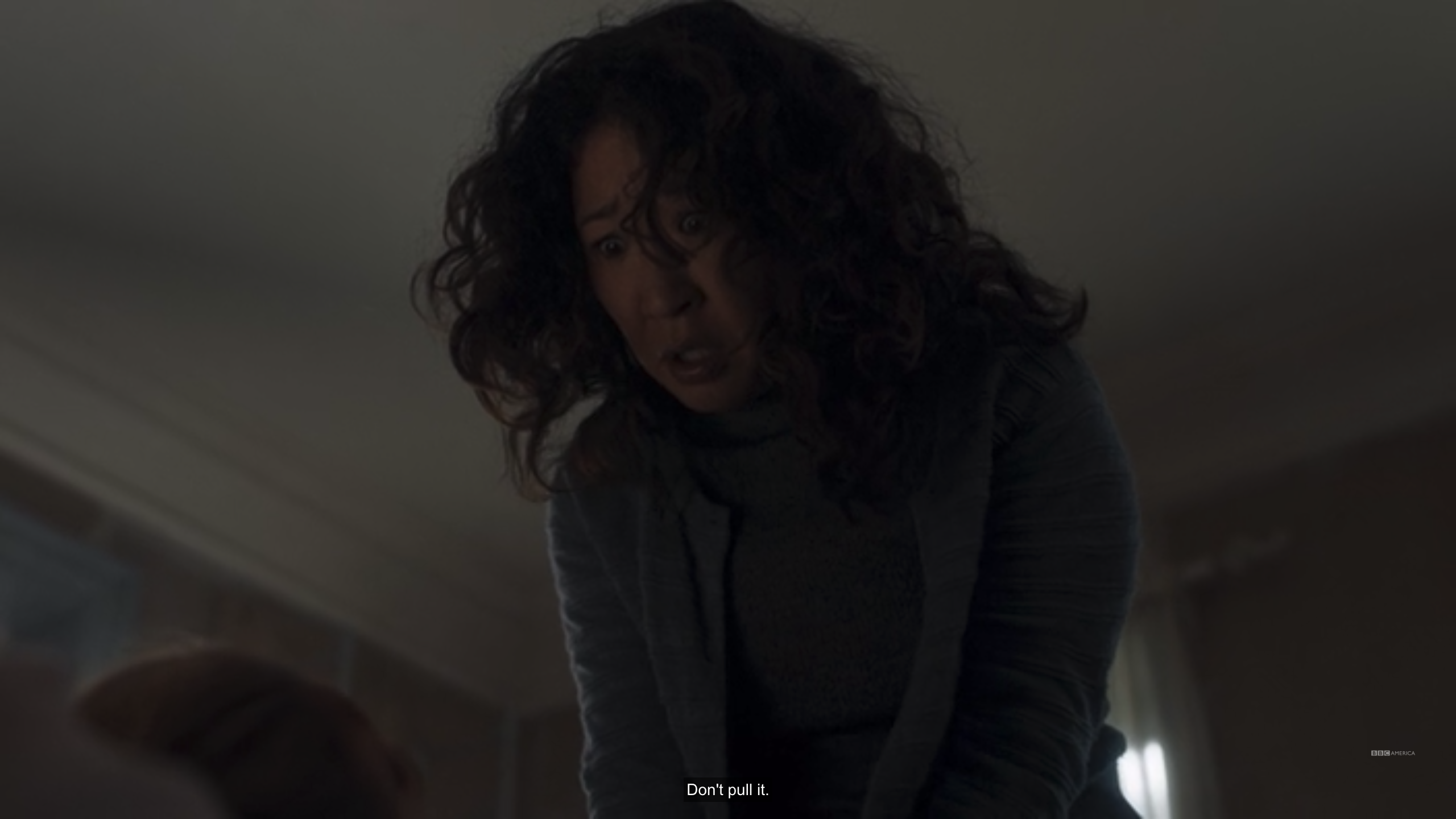
One might read this scene as reinforcing the heterosexuality of the characters, but Eve and Villanelle’s relationship has always been deeper than carnal. The nature of their desire is beyond simple categorization; instead, the series shows us, over the course of eight tight-knit episodes, how these two women gravitate toward each other affectively and psychosexually. Their lives are inextricably entangled. They want to be the other, as demonstrated by the lifestyle and personality changes they each manifest, and to an extent, be with one another, though any notion of monogamous, domestic bliss is surely thrown out the window! The series skillfully illustrates how desire can be performed and manipulated, based on gendered, affective, and intimate displays. [Note: Season two is now streaming on AMC and not only raises the killer stakes but also continues their tantalizing dance in ever brilliant fashion.]
All in all, while the archive of queer and lesbian Asian female characters on television may be scant, their desires have nonetheless been present and persistent. These two televisual examples are separated by nearly two decades and posit vastly different formations of interracial, same-sex desire and Asian American women’s sexuality. While Ally McBeal had to resort to trafficking in fleeting, fantastical scenes of female same-sex desire due to the regnant homophobia of the 1990’s, Killing Eve has completely exploded how messy and complicated the ‘desire’ between two women can be in 2019. The presence of nonnormative expressions of desire has always been ephemeral at best in American popular culture due to the strictures of white supremacy, homophobia and heteropatriarchy; yet, precisely because the gesture is always partial, and the performance never complete, it is from here that we might begin to imagine otherwise.

Comments powered by Talkyard.